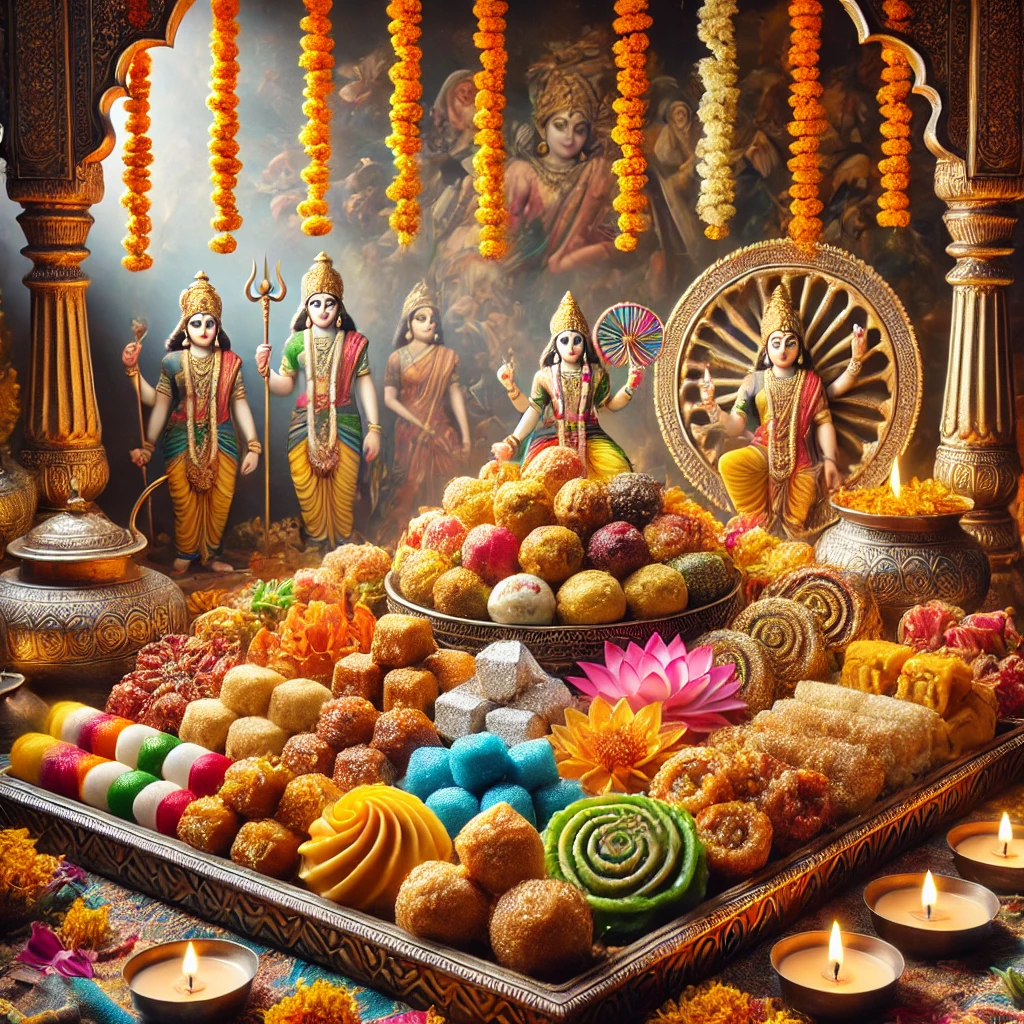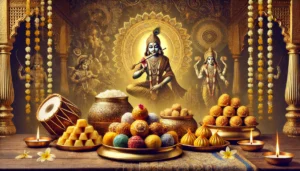
Ancient Indian sweets and mythology
Sweet Delights: Traditional Mithais for Festivals and Rituals
Festivals and rituals in India are deeply intertwined with the preparation and sharing of traditional mithais (sweets). These sweet delicacies are not merely a feast for the senses but also carry profound cultural, religious, and mythological significance. Whether it’s the creamy Peda, the delightful Modak, or the ubiquitous Ladoo, each mithai has its own story, deeply rooted in the annals of history and mythology, making them indispensable to Indian celebrations.
Peda: The Divine Offering
Peda, a simple yet delightful sweet made from khoya (reduced milk) and sugar, holds a special place in Indian religious practices. Traditionally flavored with cardamom and often garnished with nuts, Peda is believed to have originated in Mathura, the birthplace of Lord Krishna. According to legend, the sweet was first offered to Lord Krishna as a token of devotion and love, establishing a tradition that continues to this day.
During Janmashtami, the celebration of Lord Krishna’s birth, devotees prepare Peda as part of the offerings to the deity. It is believed that offering Peda can bring blessings of prosperity, happiness, and divine protection. The preparation of Peda is also symbolic of simplicity and purity, values that are deeply revered in Hinduism.
Recipe for Peda:
Ingredients: 500g khoya, 200g sugar, 1 tsp cardamom powder, nuts for garnish.
Method: Heat the khoya in a pan, stirring constantly until it softens and begins to release a pleasant aroma. Add sugar and continue to cook until it dissolves completely, creating a smooth mixture. Stir in the cardamom powder and mix well.
Allow the mixture to cool slightly before shaping it into small round discs. Garnish each Peda with a sliver of almond or pistachio, and let them set before serving.
Table of Contents
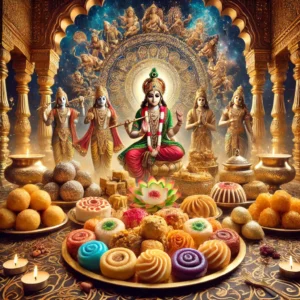
Ancient Indian sweets and mythology
Modak: The Favorite of Lord Ganesha
Modak is synonymous with Ganesh Chaturthi, a festival dedicated to Lord Ganesha, the remover of obstacles and the god of wisdom. Modak, a sweet dumpling filled with jaggery and coconut, is considered Lord Ganesha’s favorite food. The sweet holds immense spiritual significance, as it symbolizes the ultimate reward of self-realization and bliss that comes from devotion and humility.
The tradition of offering 21 Modaks to Lord Ganesha during the festival is believed to bring prosperity and remove obstacles from the devotee’s life. The number 21 is considered sacred, representing the 21 forms of Lord Ganesha and the 21 elements of life as per Hindu scriptures.
Recipe for Modak:
Ingredients: 1 cup rice flour, 1 cup grated coconut, ¾ cup jaggery, 1 tsp cardamom powder, a pinch of salt, water.
Method: To make the filling, mix grated coconut and jaggery in a pan and cook on low heat until the jaggery melts and blends with the coconut. Add cardamom powder and set aside.
For the outer covering, boil water with a pinch of salt and add rice flour, stirring continuously to avoid lumps. Once it cools slightly, knead into a smooth dough.
Shape the dough into small cups, fill with the coconut mixture, and seal by shaping into Modaks. Steam the Modaks for about 10-15 minutes until they are cooked through.
Ladoo: The Festive All-Rounder
Ladoo, with its countless variations, is a staple in Indian households during any festival or celebration. Whether it’s the nutty Besan Ladoo, the grainy Rava Ladoo, or the decadent Coconut Ladoo, this sweet is a symbol of joy and prosperity. In mythology, Ladoo is often associated with Lord Hanuman, who is believed to have a fondness for this sweet. Offering Ladoos to Lord Hanuman is thought to bestow strength, courage, and protection from evil.
Ladoo also plays a significant role during Diwali, the festival of lights. Sharing Ladoos with family, friends, and neighbors fosters a sense of community and togetherness. Each variety of Ladoo brings its own unique flavor and texture, making it a versatile choice for celebrations.
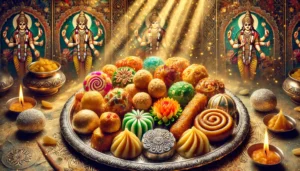
Ancient Indian sweets and mythology
Recipe for Besan Ladoo:
Ingredients: 2 cups gram flour (besan), 1 cup ghee, 1 ½ cups powdered sugar, 1 tsp cardamom powder, nuts for garnish.
Method: Roast the gram flour in ghee over a low flame until it turns golden brown and releases a nutty aroma. This process is crucial as it enhances the flavor of the Ladoo.
Remove from heat and allow the mixture to cool slightly before adding powdered sugar and cardamom powder. Mix thoroughly and shape into small round balls while the mixture is still warm.
Garnish with nuts and let the Ladoos set before serving.
The Mythological Connection
The rich tapestry of Indian mythology imbues each mithai with a deeper meaning. These sweets are not merely culinary delights but serve as an expression of devotion, love, and gratitude towards the divine. Whether it’s the story of Lord Krishna’s fondness for Peda, Lord Ganesha’s love for Modak, or Lord Hanuman’s affinity for Ladoo, each tale adds a layer of spiritual significance to these sweets.
Conclusion
Traditional mithais like Peda, Modak, and Ladoo are an integral part of Indian festivals and rituals, weaving together taste, tradition, and spirituality. They embody the essence of Indian culture, where food is not just a means of sustenance but a medium of expression, connection, and celebration. As these sweets continue to grace festive occasions, they remind us of the timeless stories and the rich heritage that shape our lives. So, the next time you savor a piece of Peda or bite into a Modak, take a moment to appreciate the history, devotion, and love that have made these sweet delights a cherished part of India’s cultural fabric.
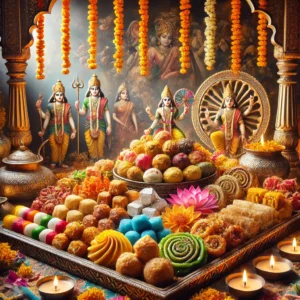
Ancient Indian sweets and mythology
FAQs on Divine Sweet Delights: Traditional Mithais and Their Mythological Roots
- What are mithais?
Mithais are traditional Indian sweets crafted from ingredients like milk, sugar, ghee, and various spices. They are deeply embedded in Indian culture, symbolizing joy, prosperity, and the essence of celebrations.
- What is the significance of mithais in Indian culture?
Mithais are more than just sweets; they embody the spirit of Indian traditions and rituals. They are used as offerings to deities, distributed during festivals, and serve as tokens of love and goodwill during significant life events.
- What are some examples of mythological connections to mithais?
Peda: This sweet is traditionally linked to Lord Krishna, particularly in the region of Mathura, where it is a popular offering in temples.
Modak: Known as Lord Ganesha’s favorite, modak is a staple offering during Ganesh Chaturthi, symbolizing wisdom and prosperity.
Ladoo: Frequently associated with Lord Hanuman, ladoos are offered in temples and during Hanuman Jayanti celebrations.
- What are the common ingredients used in mithais?
Mithais typically use ingredients such as milk, sugar, ghee, cardamom, saffron, nuts, and dry fruits. Each mithai has its distinct blend of flavors, often reflecting the region it comes from.
- How are mithais prepared for festivals and rituals?
Preparation of mithais for festivals and rituals is often a labor of love, involving traditional methods passed down through generations. The process is carried out with devotion, as the sweets are seen as sacred offerings.
- Are mithais only made during festivals?
While mithais are an integral part of festivals, they are also made for various occasions such as weddings, religious ceremonies, and even as everyday treats in many households.
- Can mithais be made at home?
Yes, many mithais can be made at home using traditional recipes. Homemade mithais are often preferred for their authenticity, freshness, and personal touch, making them even more special.
- What are some health considerations when consuming mithais?
Mithais are generally rich in sugar, fats, and calories, so moderation is recommended. For those looking for healthier options, mithais can be prepared using natural sweeteners, low-fat ingredients, or even sugar-free alternatives.
- Are there regional variations in mithais across India?
India’s diverse culinary landscape is reflected in its mithais. For example, Bengal is known for its syrupy Rosogolla, Gujarat for its Mohanthal, Tamil Nadu for its Mysore Pak, and Punjab for its creamy Barfi. Each region boasts its own specialty, influenced by local ingredients and traditions.
- Can mithais be customized for dietary preferences?
Absolutely! Mithais can be adapted to suit various dietary needs. For instance, vegan versions can use plant-based milk and ghee substitutes, while gluten-free mithais can be made using alternative flours like almond or chickpea flour.
- What are some popular mithais for different Indian festivals?
Diwali: Ladoos, barfis, and kaju katli are popular choices.
Holi: Gujiya and malpua are commonly prepared.
Ganesh Chaturthi: Modak is the quintessential sweet.
Raksha Bandhan: Soan papdi and gulab jamun are widely enjoyed.
Janmashtami: Peda and makhan (butter) are offered to Lord Krishna.
- How have modern influences affected traditional mithais?
Modern culinary trends have introduced innovative variations of traditional mithais. Fusion sweets like chocolate barfi, mango modak, and sugar-free ladoos have gained popularity, blending traditional flavors with contemporary tastes.
- Are there any special rituals involving mithais?
Yes, mithais are often central to various rituals. For example, during religious ceremonies, specific sweets are offered to deities as a sign of devotion. In weddings, mithais are exchanged between families as symbols of goodwill and celebration.
- How are mithais packaged for gifting?
Mithais are often beautifully packaged in decorative boxes, making them popular gifts during festivals and celebrations. The presentation adds to the festive spirit and enhances the joy of giving and receiving.
- Can mithais be preserved for long durations?
Some mithais have a longer shelf life due to their ingredients and preparation methods, such as dry sweets like ladoos and barfis. However, others like rasgulla and rasmalai are best consumed fresh. Proper storage in airtight containers can help extend their shelf life.
Summary
“Divine Sweet Delights: Traditional Mithais and Their Mythological Roots” delves into the rich cultural and spiritual significance of traditional Indian sweets, commonly known as mithais, that are integral to festivals and rituals. This exploration goes beyond mere recipes, offering an in-depth look at beloved sweets like Peda, Modak, and Ladoo, each carrying its own unique story and connection to Indian mythology.
The book unfolds the fascinating tales behind these delicacies, tracing their origins to ancient scriptures and legends. For instance, Modak is revered as Lord Ganesha’s favorite sweet, symbolizing wisdom and spiritual knowledge. Ladoo, often associated with Lord Hanuman, signifies strength and devotion. Peda, with its simple yet divine taste, is linked to various religious offerings and auspicious occasions.
In addition to these mythological connections, the book provides step-by-step recipes, making it a valuable resource for those who wish to recreate these traditional sweets at home. It also sheds light on the regional variations and the symbolic meanings attached to each mithai, illustrating how these sweets transcend mere culinary art to become a medium of cultural expression and devotion.
By blending culinary practices with spiritual narratives, “Divine Sweet Delights” offers readers a holistic understanding of how these sweets have become an integral part of Indian festivals and rituals, celebrating both taste and tradition in every bite.
Related Articles
- Restful Nights: Ayurvedic Remedies and Traditional Indian Practices to Overcome Insomnia and Late-Night Habits
- The Tridevi: Lakshmi, Saraswati, and Parvati – Their Roles and Powers
- “Divine Creatures of Ancient Indian Scriptures: Exploring the Role of Animals in the Vedas, Puranas, and Mahabharata”
- Nature and Spirituality: Exploring the Sacred Essence of the Himalayas, Ganga, and Other Natural Wonders”
- “Reviving the Gurukul System: Relevance and Lessons for Modern Education”
- “Exploring Greek and Indian Mythology: Similarities Between Greek and Indian Mythology “
- “Embracing Sattvic Living: Harmonizing Mind, Body, and Soul Through Food and Lifestyle”
- “Charity and Prosperity: Exploring the Concept of Daan and Its Financial Relevance in Modern Life”
- How to Build an Eco-Friendly Home Inspired by Vastu Shastra
- Comparison of Ancient and Modern Sports: How Traditional Sports Have Influenced Contemporary Games
- “Timeless Lessons from Ancient Tales: Linking Samudra Manthan and Ganga’s Descent to Modern Ecological Challenges”
- “Reviving Sanskrit: How AI is Preserving Ancient Languages for the Future”
- “Mathura: The Sacred Land of Lord Krishna’s Divine Leelas”
- Investing for Future Generations: Lessons from Indian Traditions on Legacy Building and Wealth Preservation
- “Ancient Indian Wisdom: Timeless Lessons for Tackling Today’s Climate Crisis”
- “Artificial Intelligence and Spirituality: Transforming Ancient Practices for the Modern World”
- “Gold and Real Estate in India: Timeless Assets Shaping Financial Strategies”
- Tradition Meets Innovation: The Evolution of Technology in Hindu Rituals
- End-of-World Myths: Exploring Kali Yuga in Hinduism and Ragnarök in Norse Mythology
- Garuda, Pegasus, and Dragons: The Universal Ties of Mythical Beasts Across Cultures
- “Ancient Vimanas: Mythical Flying Machines or Evidence of Advanced Technology?”
- Time Travel in Hindu Mythology: The Fascinating Tales of Kakudmi and King Raivata
- “Divine Feminine Power in Hindu Mythology: The Legends of Durga, Saraswati, and Lakshmi”
- “Divine Beings of Sanatan Dharma: The Spiritual Significance of Sacred Animals in Hinduism”
- “Symbolism in Mythological Art: Unlocking Hidden Meanings in Ancient Temple Carvings”
- “Exploring Technological Advancements in Ancient India and Civilizations: Vimana, Metallurgy, & Water Management systems”
- Unveiling the Mysteries: Ancient Temples of Sanatan Dharma , Mysterious Temples of India
- “The Scientific Knowledge of Sanatan Dharma: Ancient Wisdom Meets Modern Science”
- Ancient Indian Sports and Games: Celebrating a Legacy of Skill, Strength & Strategy”
- “Exploring the Cosmic Link: The Connection Between Astronomy and Vedic Astrology”
- The Power of Sanskrit: Unlocking the Divine Language of the Gods
- “The End of Kaliyuga: A Sanatan Insight into the World’s Final Chapter”
- Explore more articles on Prachin Sanatan Yuga.
Traditional mithais like Peda, Modak, and Ladoo are an integral part of Indian festivals and rituals, weaving together taste, tradition, and spirituality. They embody the essence of Indian culture, where food is not just a means of sustenance but a medium of expression, connection, and celebration. As these sweets continue to grace festive occasions, they remind us of the timeless stories and the rich heritage that shape our lives. So, the next time you savor a piece of Peda or bite into a Modak, take a moment to appreciate the history, devotion, and love that have made these sweet delights a cherished part of India’s cultural fabric.
In addition to these mythological connections, the book provides step-by-step recipes, making it a valuable resource for those who wish to recreate these traditional sweets at home. It also sheds light on the regional variations and the symbolic meanings attached to each mithai, illustrating how these sweets transcend mere culinary art to become a medium of cultural expression and devotion.
Ancient Indian sweets and mythology Ancient Indian sweets and mythology Ancient Indian sweets and mythology Ancient Indian sweets and mythology Ancient Indian sweets and mythology Ancient Indian sweets and mythology Ancient Indian sweets and mythology
Ladoo, with its countless variations, is a staple in Indian households during any festival or celebration. Whether it’s the nutty Besan Ladoo, the grainy Rava Ladoo, or the decadent Coconut Ladoo, this sweet is a symbol of joy and prosperity. In mythology, Ladoo is often associated with Lord Hanuman, who is believed to have a fondness for this sweet. Offering Ladoos to Lord Hanuman is thought to bestow strength, courage, and protection from evil.
Ancient Indian sweets and mythology Ancient Indian sweets and mythology Ancient Indian sweets and mythology Ancient Indian sweets and mythology Ancient Indian sweets and mythology Ancient Indian sweets and mythology
